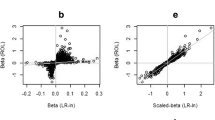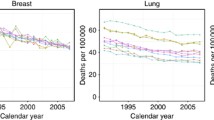Abstract
Objective: The World Health Organization (WHO) has recently introduced a new world standard population for the production of age-standardized rates. In this study we compare cancer rates standardized to this population with those computed using reference populations in current practice, particularly the world standard of Segi (1960), in order to evaluate their adequacy as estimators of relative risk in diverse population groups and over time. Methods: Incidence and mortality rates standardized using these reference populations were calculated and compared for various cancers. Standardized rate ratios were compared with more efficient methods of approximating relative risk, the Mantel & Haenszel and maximum-likelihood estimators. The differences were tested by taking a synthesis of the relative risks and by taking into account whether effects were homogeneous across age strata or not. Results: There were no statistically significant differences between the relative risk estimates based on direct standardization and those obtained using Mantel & Haenszel (p < 0.99), or maximum-likelihood techniques (p > 0.99), regardless of whether the Segi or the WHO world population was used as the standard. Conclusions: Ratios of rates age-standardized using the world standard of Segi approximate relative risk as precisely as the WHO standard. For this, and important practical reasons, it is considered unnecessary to replace the Segi standard population for comparisons between cancer rates.
Similar content being viewed by others
References
Ahmad OE, Boschi-Pinto C, Lopez AD, Murray CJL, Lozano R, Inoue M (2000) Age standardization of rates: a new WHO standard GPE Discussion Paper Series: No. 31. Geneva: World Health Organization.
Segi M (1960) Cancer Mortality for Selected Sites in 24 Countries (1950–57). Sendai, Japan: Tohoku University of Medicine.
United Nations (1999) World Population Growth and Demographic Structure, New York: United Nations.
Parkin DM, Whelan SL, Ferlay J, Raymond L, Young J, eds. (1997) Cancer Incidence in Five Continents, Vol. VII. IARC Scientific Publications No. 143. Lyon: IARC.
World Health Organization (1998) World Health Statistics Annual 1996. Geneva: World Health Organization.
Ries LAG, Eisner MP, Kosary CL, et al., ed. (2000) SEER Cancer Statistics Review, 1973–1997. Bethesda, MD: National Cancer Institute.
Rothman KJ, Greenland S (1998) Modern Epidemiology, 2nd edn. Philadelphia: Lippincott-Raven.
Estève J, Benhamou E, Raymond L (1994) Descriptive Epidemiology. IARC Scientific Publication No. 128. Lyon: IARC.
Shalala DE (1998) HHS policy for changing the population standard for age adjusting death rates: memorandum from the Secretary US Department of Health and Human Services.
Anderson RN, Rosenberg HM (1998) Report of the Second Workshop on Age Adjustment. National Center for Health Statistics. Vital Health Stat 4: 1–37.
Taylor TH, Anton-Culver H (2000) Let's leave the date out of the name of the standard population. J Natl Cancer Inst 92: 1269–1270.
United Nations (1999) World Population Prospects: the 1998 revision, Vol. 1: Comprehensive Tables. New York: United Nations.
Author information
Authors and Affiliations
Rights and permissions
About this article
Cite this article
Bray, F., Guilloux, A., Sankila, R. et al. Practical implications of imposing a new world standard population. Cancer Causes Control 13, 175–182 (2002). https://doi.org/10.1023/A:1014344519276
Issue Date:
DOI: https://doi.org/10.1023/A:1014344519276




